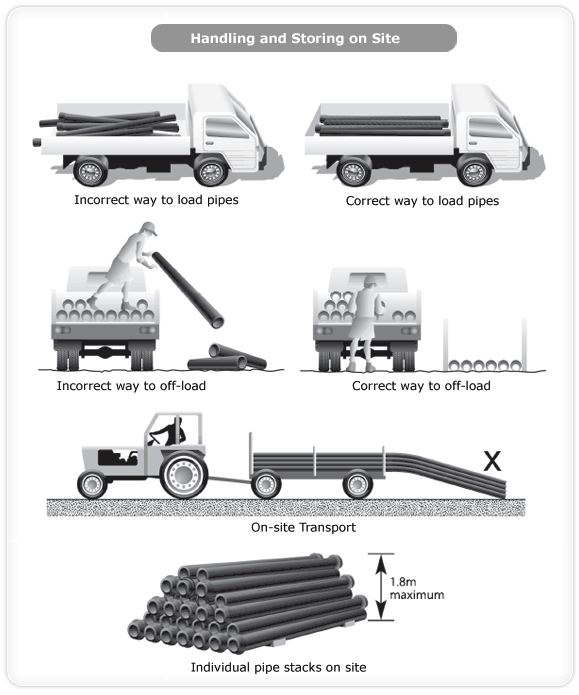Transport & Storage
TRANSPORT CRATES
Generally, pipes are delivered prepacked in crates of standard quantities. In these crates, pipes are held by steel bands and timber stretchers.
♦ LOOSE PIPES AND FITTINGS
When vehicles with a flat bed are used for transporting loose pipes, make sure the bed is free of nails and other projections. Support pipes throughout their length.
When loading socket and spigot pipes, place the sockets at alternate ends of each layer. Allow the sockets to protrude so that the pipes are evenly supported along their entire length.
Load pipes so that they do not overhang the vehicle by more than one meter.
Always load pipes with larger diameter and thicker walls before those with smaller diameters and thinner walls.
Make sure vehicles have adequate side supports at approximately 2 meter spacing, and that all uprights are flat, with no sharp edges. Secure pipes during transit.
HANDLING
Always be careful to avoid damage when handling pipe. Cold weather reduces the impact strength of uPVC, so take extra care when handling pipe in wintry conditions.
When unloading crates mechanically, use either nylon belt type slings or fork lift trucks with smooth forks. Metal slings, hooks or chains must not come into direct contact with the pipe.
Load and unload loose pipes by hand and avoid using skids. When loose pipes have been transported one inside the other, always remove the inner pipes first.
Do not drop or drag pipes.
STORAGE
♦ CRATES
Store crates on a reasonably flat surface free from sharp projections likely to damage the pipes.
Crates can easily be stored up to three high without extra side supports or bearers.
When 200mm, 250mm and 315mm pipe bundles are cut they must be given side supports at least every 2 meters. These supports should preferably consist of battens at least 75mm wide.
Take care when removing pipes from bundles as the straps are under considerable tension and may fail when cut.
♦ LOOSE PIPES
Store loose pipes on a reasonably flat surface free of sharp projections. Provide side supports at least every 2 meters. These supports should preferably consist of battens at least 75mm wide.
Ideally, loose pipes should be uniformly supported throughout their entire length. If this is not possible, place timber supports at least 75mm wide at 1 meter maximum centers beneath the pipes.
Stack pipes of different size and wall thickness separately. If this is not possible, stack pipes with larger diameters and thicker walls under those with smaller diameters and thinner walls.
♦ STACKING GUIDELINE
Do not stack uncrated pipes more than six layers in height or above a maximum height of 1.8 meters. Always store pipes under shade cloth if periods outdoors exceed 3 months.

